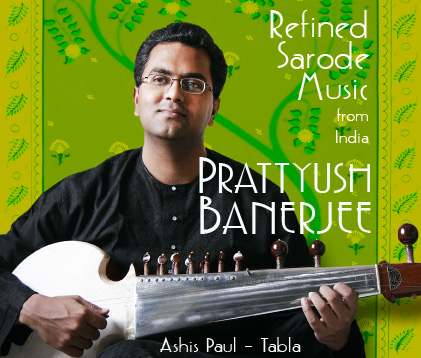Refined sarode music by Prattyush Banerjee
Posté dans ÉCOUTER, HINDOUSTAN, REGARDER par hansbosma - Date : avril 17th, 2010Prattyush Banerjee, sarode & Ashis Paul, tabla
live in concert, in Belgium, the Netherlands & Germany
LAST
LAST UPDATE: Sat. 24th our musicians reached safely – All concerts are confirmed!
SUNDAY 25/4 | LEUT (BE)
Bach Festival | 22:00 | Sint Pieterskerk | T. +32 (0) 89/76 97 97 | http://www.ccmaasmechelen.be
su 25/04 | BRUSSELS (BE) | 13h30 | ArtBase – Zandstraat 29
T. +32 (2) 217 29 20 | http://www.art-base.be
tu 27/04 | GRONINGEN (NL) | 20h15 | Oosterpoort – Trompsingel 27
T. +31 (0) 50-368 0 368 | www.de-oosterpoort.nl
th 29.04 | AMSTERDAM (NL) | 20h00 | Tropentheater, Linnaeusstraat 2C
T. +31 (0) 20 5688 500 | www.tropentheater.nl
sa 1.5 | DEN HAAG (NL) | 20h30 | Korzo, Binckhorstlaan 36
T. +31 (0) 70 3637 540 | www.korzo.nl
su 2.5 | AACHEN (DE) | with ARUP SEN GUPTA – Tabla | 18h15 | Atelier 21 | Jülicher Strasse 21
T. +49 (0) 241 159 723 | www.atelier-21.net

Prattyush Banerjee explores ever new dimensions.
His inventive technique and broad musical sensitivity give him the flexibility to harmoniously combine new elements with the tradition of classical music. Thus, he reproduces the complex vocal tappa-style on his instrument. With Prattyush Banerjee, music is not a means but a goal in itself. No sentimentality or exagerated pathos, no pretentious fireworks. When he plays, the raga is king, in a thrilling way.
Here is Prattyush’s own article, to be distributed amongst the audience of his Bach concert on Sunday 25th:
The sarode is one of the very well known stringed instruments in the world of Indian Raga Music and is perhaps only second to sitar in terms of popularity. However, even as it finds its place in today’s global music, there are major limitations in its construction and playability that restrict wider application in various kinds of music. Firstly, being a fretless instrument staccato notes are most difficult to play. Also, because of a tapering fingerboard, notes in the high register are played with great difficulty. Like most other Indian instruments, playing double stops or harmony notes also become quite impossible. Last but not the least, since all Indians study music from a fixed tonic, the concept of transpositions is very alien to us and an utmost difficult idea on the sarode. Such shortcomings together with my personal inadequacies as a musician make the task of decoding Bach’s music and reproducing it on my instrument truly Herculean.
I am not trying to play the original pieces (which are impossible in any case) but attempting to draw similarities between some of his music and our Indian Ragas. Firstly, I have framed my alaap (adlib introductory part) based on some lines from a Bach piece. Further, I have also adapted some of his key lines or phrases, transforming them into a bandish (compositions set to a rhythm cycle). The improvisational portions basically, follow the Indian mode, with vistar, taans and tihais all set to the chosen taal (rhythm cycle) together with tabla accompaniment.
I present this recital with total humility and submission to the great tradition of European classical music and offer my apologies in advance to all who might not find my attempts acceptable.
Item 1 The Prelude in C Major has impressed me from a very early age. It was in fact my teacher, Pandit Buddhadev Das Gupta who first drew our attention to the 12-123-123 rhythmic structure. While Bach proceeded along a chord progression I have tried to traverse through key phrases of different ragas, the changes sometimes smooth and soothing but often, rather harsh and sudden. For those who would be interested, the ragas I cover are, Rageshree, Gorakh Kalyan, Desh, Shyam Kalyan, Jaijaiwanti, Bageshree, Malkauns, Kaunsi Kanhra, Yaman, Puriya, Bhatiyar, Hindol, Kalavati and finally Bhairavi. This piece is without tabla accompaniment.
Item 2 Bach’s chorale, Jesu, Joy of Man’s Desiring has great similarities with a certain version of the raga, Tilak Kamod. I have more or less kept the opening lines of the piece intact with minor adjustments to fit it into a jhaptaal (10 beats) bandish with tabla accompaniment. The alaap and jor have the flavour of the original Bach piece as well.
Item 3 The opening line from Toccata in C-minor (BWV 911) becomes a fast composition in teentaal (16 beats) with tabla accompaniment. The raga closest to this is Kirwani, the harmonic minor scale in India with a touch of the flattened fifth and seventh. This also opens with a short alaap and jor.
Item 4 My source is the violin sonata, BWV 1017 (Part 3). It has a strong essence of raga Shudh Bilawal and Yamani Bilawal. However, the grand poise on the major seventh (in an almost hidden glide from the fifth) and a sudden introduction of the flat seventh (giving us a flavour of raga Khamaj) as also a the flat fifth (a tinge of Yaman) is a unique combination and the resultant mood, in my humble opinion, is unheard of in any known Indian raga. In fact, I may safely add that a new raga is born right here. This obviously reiterates the relevance and greatness of Bach and so much so, that his works continue to inspire musicians separated by several thousand kilometers and generations. Here I play a short alaap followed by a medium tempo bandish set to rupaktaal (7 beats).